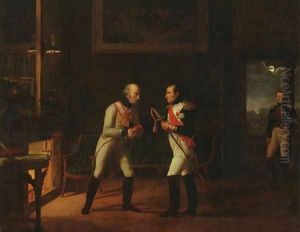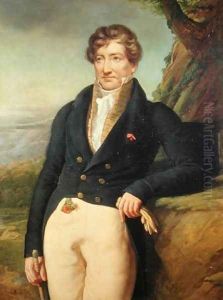Marie Nicolas Ponce-Camus Paintings
Marie Nicolas Ponce-Camus was a French artist whose career spanned the late 18th and early 19th centuries, a period marked by significant political, social, and artistic upheavals. Born in 1778, Ponce-Camus lived through the French Revolution, the Napoleonic era, and the Restoration period, experiences that influenced his art in various ways. He is less well-known than his contemporaries, yet his work provides insightful perspectives into the era's aesthetic movements and historical context.
Ponce-Camus was primarily known for his work as a miniaturist and portrait painter, a popular genre of the time that catered to the tastes and demands of the French elite and middle-class patrons. His miniatures, often created with watercolor on ivory, are noted for their detailed precision and the ability to capture the personality and essence of his subjects. This was a period when such intimate portraits were highly prized, reflecting both personal sentiment and social status.
Despite the turbulent times, Ponce-Camus's career flourished under various political regimes. He exhibited his work at the Paris Salon, the official art exhibition of the Académie des Beaux-Arts in Paris, which was a significant achievement for artists of the era. His participation in these exhibitions demonstrates his acceptance and respect within the art community of his time.
The body of Ponce-Camus's work reflects the transition from the neoclassical style, which emphasized clarity, order, and balance, to the more expressive and emotionally charged Romanticism that began to emerge in the early 19th century. However, detailed information about his personal life, artistic training, and the wider reception of his work remains limited, as is the case with many artists of the period who did not reach the highest echelons of fame.
Marie Nicolas Ponce-Camus passed away in 1839. While he may not be as widely recognized as some of his contemporaries, his art provides an important window into the visual culture and societal changes of his time. Today, his works are valuable to historians and collectors alike for their beauty and historical significance, offering insights into the personal and political landscapes of early 19th-century France.

